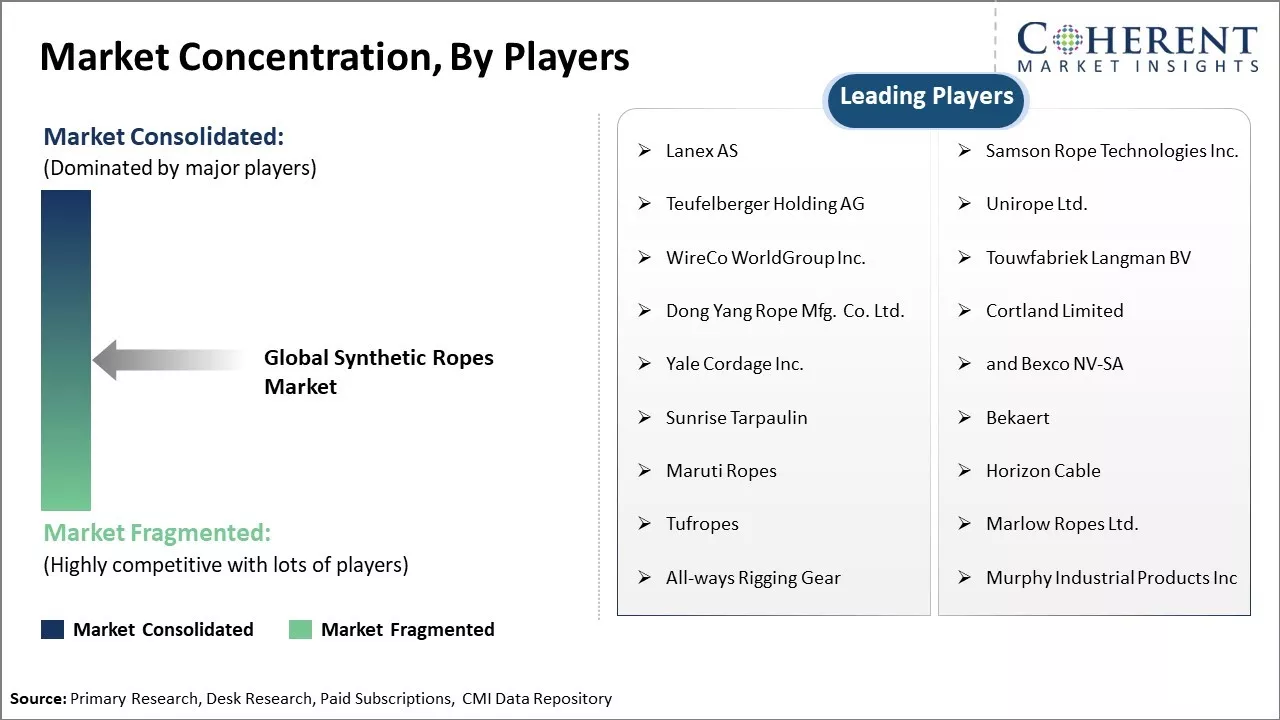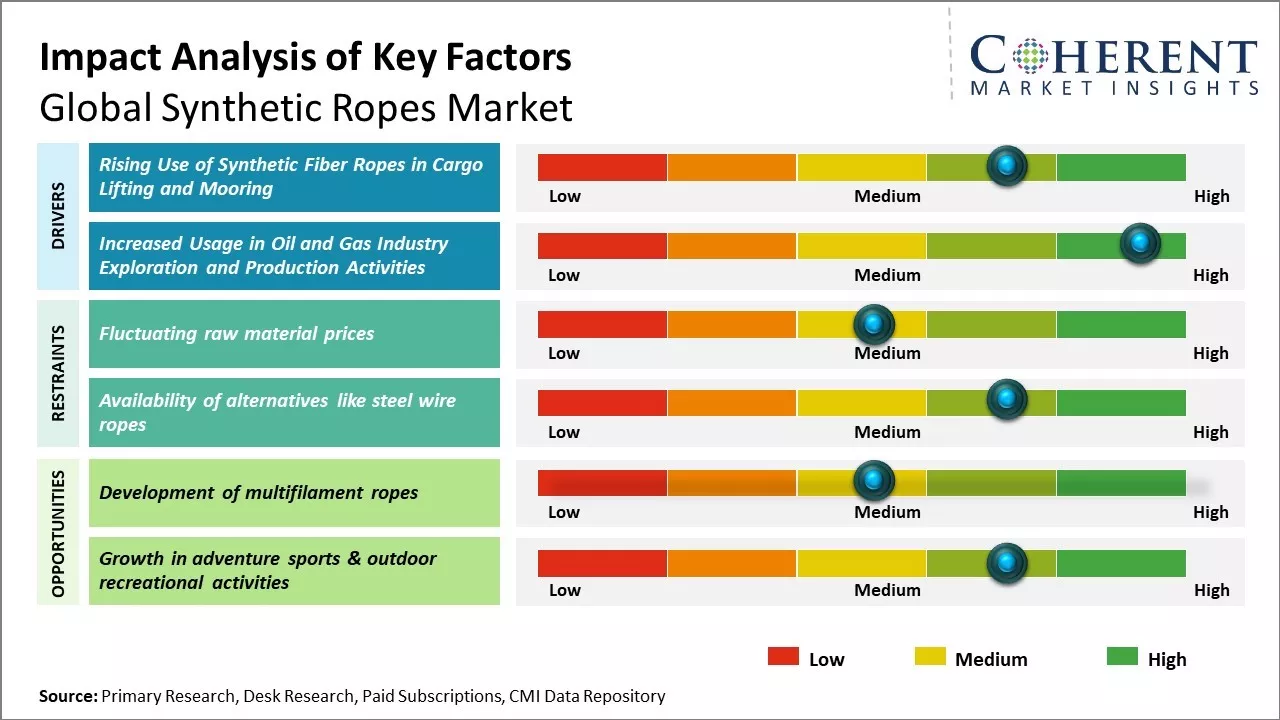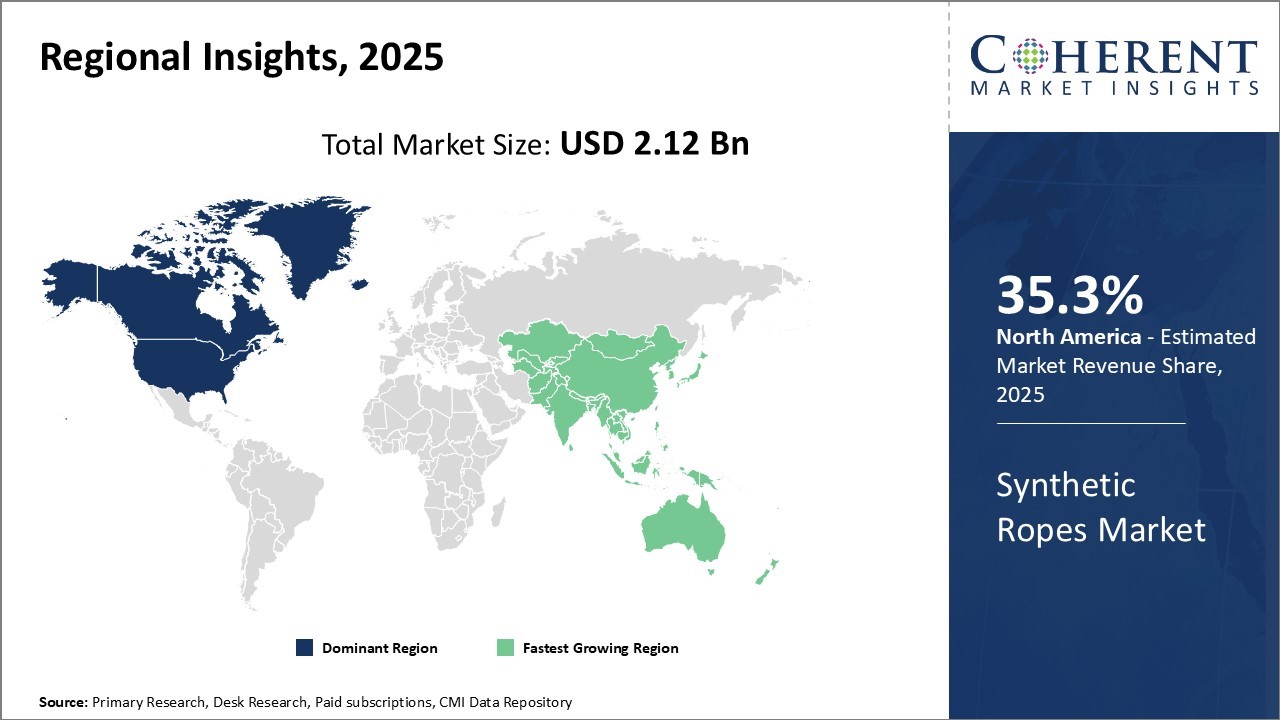The synthetic ropes market is estimated to be valued at USD 2.12 Bn in 2025 and is expected to reach USD 3.19 Bn by 2032, exhibiting a compound annual growth rate (CAGR) of 6.0% from 2025 to 2032.
The global synthetic ropes market is poised for steady growth through 2032, driven by the rising demand across diverse end-use industries such as oil & gas, marine, construction, and industrial lifting. The superior performance characteristics of synthetic ropes—such as high strength-to-weight ratio, corrosion resistance, and ease of handling—have led to increased adoption over traditional steel wire ropes. Polyester, in particular, has emerged as the dominant material due to its durability and wide applicability across sectors.
The oil and gas industry remains a major driver of the market growth, given the extensive use of synthetic ropes in upstream, midstream, and downstream operations. Additionally, technological advancements in rope manufacturing and enhanced safety standards are expected to further fuel the market expansion.
However, the market faces challenges including fluctuating raw material prices, competition from low-cost alternatives, and concerns around the environmental impact of synthetic materials. Despite these barriers, increasing investments in offshore exploration and infrastructure development are likely to support long-term growth.
The synthetic ropes industry is undergoing a significant transformation through the integration of artificial intelligence (AI), enhancing product innovation, predictive maintenance, and operational efficiency across key sectors such as offshore energy, mining, and maritime logistics.

To learn more about this report, Download Free Sample
|
Current Events |
Description and its impact |
|
Integration of AI and Predictive Maintenance Technologies |
|
|
Growth of Floating Offshore Wind Sector |
|
Uncover macros and micros vetted on 75+ parameters: Get instant access to report

To learn more about this report, Download Free Sample
The synthetic ropes market is experiencing strong momentum due to rising adoption in oil and gas exploration and production operations. Synthetic ropes made from nylon, polyester, and polyethylene are increasingly preferred over traditional steel wire ropes for critical applications such as drilling rigs, production platforms, and subsea pipelines.
As global energy demand continues to drive expansion into deeper waters and more complex oil and gas projects, the need for high-performance, reliable, and safe mooring and lifting solutions has intensified. Synthetic ropes are proving to be a safer and more efficient alternative, reducing the risk of equipment failure and enhancing operational safety.
Major rope manufacturers are responding with specialized product innovations tailored to oilfield demands, such as rig movement, riser tensioning, and heavy equipment lifting. This trend is expected to propel further growth in the synthetic ropes market, as oil and gas companies increasingly invest in advanced fiber technologies for harsh and high-risk environments.
The synthetic ropes market is poised for substantial growth driven by the rapid expansion of the offshore renewable energy sector, particularly offshore wind farms. As global energy policies shift toward decarbonization and sustainability, investment in offshore wind infrastructure is accelerating across Europe, Asia-Pacific, and North America. These developments demand robust and lightweight mooring, towing, and handling solutions, especially for floating wind turbines and deepwater installations where traditional steel wire ropes fall short.
Synthetic ropes made from high-performance fibers like HMPE (High Modulus Polyethylene), aramid, and LCP (Liquid Crystal Polymer) offer unmatched benefits in these settings, including corrosion resistance, buoyancy, reduced installation costs, and ease of handling. These properties make them ideal for anchoring floating platforms, tensioning systems, and cable-laying operations under dynamic marine conditions.
With increased governmental support, favorable regulatory frameworks, and technological advances in floating wind turbine designs, the offshore renewables sector represents a high-potential, long-term growth avenue for synthetic rope manufacturers. Companies that invest in R&D and strategic partnerships to cater to this segment are well-positioned to capture a significant share of this emerging opportunity.
In 2025, polyethylene is projected to hold the largest share of the global synthetic ropes market at approximately 46.1%. This dominance is attributed to polyethylene’s exceptional combination of high tensile strength, low weight, buoyancy, and excellent resistance to moisture and chemicals. These features make it highly suitable for marine, fishing, offshore oil & gas, and industrial applications.
Polyethylene ropes, particularly those made from high-modulus polyethylene (HMPE), outperform many other materials in terms of strength-to-weight ratio and durability in harsh environments. Compared to nylon and polyester, polyethylene is more resistant to UV degradation and floats on water, making it ideal for mooring, towing, and netting operations.
Additionally, advances in ultra-high molecular weight polyethylene (UHMWPE) are driving innovations in safety and performance, expanding the material's use in high-risk industries. With sustainability becoming a focus, polyethylene's recyclability and long service life further contribute to its growing market demand.
The oil and gas sector is projected to hold 34.8% of the synthetic ropes market in 2025, driven by high demand across upstream, midstream, and downstream operations. Polypropylene and nylon ropes are preferred for their chemical resistance and durability in harsh oilfield environments. Polyester ropes offer lightweight and high tensile strength, reducing load on lifting equipment. Non-conductive nylon and polypropylene ropes improve safety in explosive environments, while UV resistance extends rope lifespan in outdoor applications. Polypropylene’s ability to float makes it suitable for offshore oil extraction and marine operations.
Application: Ultra-High Molecular Weight Polyethylene (UHMWPE) fibers are being increasingly used to manufacture synthetic ropes that offer superior tensile strength while remaining extremely lightweight. These ropes provide better load-bearing capacity and durability, making them ideal for marine, offshore, and rescue operations.
In April 2022, Teufelberger acquired the Polish competitor Maillis Plastics Solutions (MPS) to expand its plastics processing business area. This strategic move enhances Teufelberger's capabilities in manufacturing UHMWPE ropes, supporting their growth in various industrial sectors.
Application: Integration of fiber optic or piezoelectric sensors within synthetic ropes allows continuous monitoring of tension, strain, and wear. These smart ropes improve safety by providing early warnings of potential failures in critical lifting, mooring, or rescue operations.
A study published in Applied Ocean Research developed an acoustic sensor to monitor synthetic mooring lines, utilizing polymer fiber optic technology and Optical Time Domain Reflectometry (OTDR) techniques for condition monitoring. This approach enables real-time detection of strain and potential damage in synthetic ropes used in marine applications.

To learn more about this report, Download Free Sample
North America has remained a dominant player in the global synthetic ropes market and is expected to hold 35.3% share in 2025. This leadership is driven by the strong presence of key manufacturers and end-use industries in the U.S. and Canada.
Growth is supported by high demand from marine, construction, and oil & gas sectors. The region benefits from advanced synthetic fiber and petrochemical industries, enabling raw material suppliers to provide high-quality inputs at competitive prices. This reduces import dependence and helps maintain competitive pricing for finished ropes.
Additionally, well-established manufacturing technology and R&D infrastructure drive frequent product innovations, catering to evolving industry and application needs.
Asia Pacific has emerged as the fastest growing regional market for synthetic ropes in recent years. Countries like China, India, Indonesia, and Australia are driving this growth, fueled by rapid infrastructural development, shipping industry expansion, and offshore oil exploration.
The region’s industrialization and expanding manufacturing sectors are boosting demand across multiple end-use industries. Favorable policies supporting domestic fiber, polymer, and petrochemical industries enable greater production integration and localized supply chains.
Additionally, several leading global synthetic rope manufacturers have established or expanded their bases in Asia Pacific to capitalize on these opportunities. The growing presence of regional and international players has made synthetic ropes increasingly accessible throughout the price-sensitive markets in the region.
The U.S. synthetic ropes market remains a significant contributor to the global landscape, driven by high demand from industries such as marine, oil & gas, construction, and logistics. The country’s well-established manufacturing base and strong presence of key players like Samson Rope Technologies, New England Ropes, and Yale Cordage support steady market growth.
Market expansion is fueled by advanced production technologies, a robust supply chain for raw synthetic fibers, and continuous innovation in high-performance ropes including UHMWPE and polyester variants. The adoption of smart ropes with embedded sensors for real-time monitoring is gaining traction to enhance operational safety in critical sectors.
Synthetic ropes designed for demanding industries such as offshore oil & gas, marine mooring, and heavy construction typically range from US$ 10 to US$ 30 per meter, depending on material type (e.g., UHMWPE, polyester), tensile strength, and rope diameter.
Example: A 100-meter UHMWPE rope priced at US$ 25 per meter would cost approximately US$ 2,500, with pricing influenced by certifications, specialized coatings, and rope construction (braided vs. twisted).
Synthetic ropes used in less demanding applications, such as agriculture, general lifting, or towing, are priced between US$ 2 to US$ 8 per meter, mostly made from polypropylene or nylon.
Example: A 50-meter polypropylene rope priced at US$ 5 per meter costs about US$ 250, often sold in bulk to meet budget-conscious industrial or commercial needs.
Raw materials such as polyester and polypropylene fibers constitute 40–60% of total production costs. Price fluctuations in petrochemical feedstocks (polymer resin prices) can impact synthetic rope prices by 5–15%. Advanced rope manufacturing technologies (e.g., braiding machines and fiber treatments) add another 10–20% to costs.
Example: In 2023, a surge in polyethylene prices led to a 7% increase in polyester rope costs globally.
Wholesale pricing usually adds a 15–30% margin, while retail markups can range from 30%–60%, especially for specialized ropes used in marine and offshore sectors. Online B2B platforms may charge commission fees of 10%–15%.
Example: A rope wholesaled at US$ 15 per meter may retail between US$ 20 and US$ 30 per meter, depending on distribution channels, certification costs, and after-sales services.
| Report Coverage | Details | ||
|---|---|---|---|
| Base Year: | 2024 | Market Size in 2025: | USD 2.12 Bn |
| Historical Data for: | 2020 To 2024 | Forecast Period: | 2025 To 2032 |
| Forecast Period 2025 to 2032 CAGR: | 6.0% | 2032 Value Projection: | USD 3.19 Bn |
| Geographies covered: |
|
||
| Segments covered: |
|
||
| Companies covered: |
Lanex AS, Samson Rope Technologies Inc., Teufelberger Holding AG, Unirope Ltd., WireCo WorldGroup Inc., Touwfabriek Langman BV, Dong Yang Rope Mfg. Co. Ltd., Cortland Limited, Yale Cordage Inc., Bexco NV-SA, Sunrise Tarpaulin, Bekaert, Maruti Ropes, Horizon Cable, Tufropes, Marlow Ropes Ltd., All-ways Rigging Gear, and Murphy Industrial Products Inc |
||
| Growth Drivers: |
|
||
| Restraints & Challenges: |
|
||
Uncover macros and micros vetted on 75+ parameters: Get instant access to report
*Definition: The synthetic ropes market involves the manufacturing and sales of synthetic fiber ropes. Synthetic ropes are made using synthetic fibers such as polyester, polypropylene, nylon, and polyethylene. They offer advantages over natural fiber ropes such as stronger tensile strength, resistance to saltwater damage, and lower rotational stretch. Synthetic ropes find applications in various industries including marine & fishing, oil & gas, mining, construction, sports & adventure, and others. The global synthetic ropes market has been growing steadily due to increasing demand from end-use industries.
Share
Share
About Author
Pankaj Poddar is a seasoned market research consultant with over 12 years of extensive experience in the fast-moving consumer goods (FMCG) and plastics material industries. He holds a Master’s degree in Business Administration with specialization in Marketing from Nirma University, one of India’s reputed institutions, which has equipped him with a solid foundation in strategic marketing and consumer behavior.
As a Senior Consultant at CMI for the past three years, he has been instrumental in harnessing his comprehensive understanding of market dynamics to provide our clients with actionable insights and strategic guidance. Throughout his career, He has developed a robust expertise in several key areas, including market estimation, competitive analysis, and the identification of emerging industry trends. His approach is grounded in a commitment to understanding client needs thoroughly and fostering collaborative relationships. His dedication to excellence and innovation solidifies his role as a trusted advisor in the ever-evolving landscape of not only FMCG but also chemicals and materials markets.
Missing comfort of reading report in your local language? Find your preferred language :
Transform your Strategy with Exclusive Trending Reports :
Frequently Asked Questions
Joining thousands of companies around the world committed to making the Excellent Business Solutions.
View All Our Clients